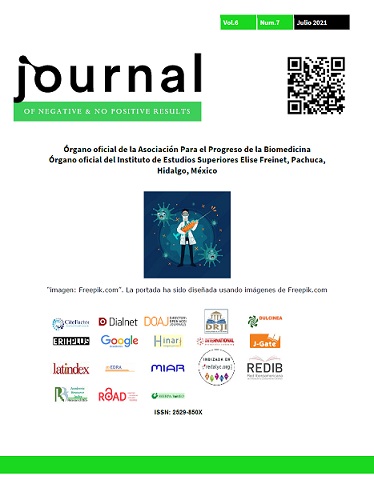Quantification of specific lectin activity in teosinte Zea diploperennis
DOI:
https://doi.org/10.19230/jonnpr.3860Keywords:
Lectin activity, total protein, Zea diploperennis, Ustilago maydisAbstract
Objective. To evaluate the specific activity of lectin in healthy and infected teosinte Zea diploperennis with Ustilago maydis.
Materials and methods. Zea diploperennis seedlings of 6 days of growth were inoculated with Ustilago maydis. Total protein concentration and hemagglutinating activity of crude extracts of healthy and infected teosinte were evaluated in microtiter plates with 3% type O red cells following the technique of serial double dilutions for 6 days.
Results. The concentration of total proteins increases in healthy coleoptile during each day of its growth. Not so in infected teosinte where the curve shows a downward trend from the moment of inoculation. The specific lectin activity decreases in both cases from the first day of quantification.
Conclusions. The evident reduction in lectin activity in infected teosinte compared to healthy teosinte could explain the susceptibility of this teosinte to said phytopathogen. Although the participation of the teosinte and corn lectins in the defense mechanism against Ustilago maydis has not yet been clarified, the results obtained contribute to the understanding of the effect that the concentration of lectin and protein can have on resistance in teosinte.
Downloads
References
Goldstein I. J., Hughes R. C., Monsiony M., Osawa T., Sharon N. What should be called a lectin? Nature. 1980; 285;66.
Chrispeels, M. J.; Raihhel, N. V. Lectins, lectin genes, and their role in plant defense. Plant Cell. 1991; 3 (1); 1-9.
Pérez-Santiago, A.; Saavedra, E.; Pérez-Campos, E.; Córdoba, F. Effect of plant lectins on Ustilago maydis in Vitro. Cell Mol. Life Sci. 2000; 57; 1986-99.
Martínez-Cruz, M, Zenteno, E, Córdoba F. Purification and characterization of a galactose-specific lectin from corn (Zea mays) coleoptile. Biochim. Byophys. Acta. 2001; 1568; 37-44.
Martinez-Cruz, M.; Cordoba, F. Isolation of fully active and stable teosinte coleoptile lectins. Prep. Biochem. Biotechnol. 2000; 30; 199-208.
Iltis, H. H. Homeotic sexual translocations and the origin of maize (Zea mays, Poaceae): A new look at an old problem. Econ. Bot. 2000; 54; 7-42.
Pérez Díaz MC, Sánchez Medina MA, Pina Canseco MS, Pérez Campos E, García-Montalvo IA, Pérez Santiago AD. Inducción de infección en Teosinte (Zea diploperennis) con el fitopatógeno Ustilago maydis. JONNPR. 2017; 1(1):17-22. DOI: 10.19230/jonnpr.1154
Iltis H. H. and J. F Doebley. Taxonomic of Zea (Gramineae) II. Subspecifics categories in the Zea mays complex and a generic synopsis. Amer. J. Bot. 1980; 67; 994-1004.
Matías L. G. Inducción de la infección en coleoptilos de teosinte Zea diploperennis con Ustilago maydis. Tesis de licenciatura. Instituto Tecnológico de Oaxaca. 2013.
Bradford M. M. A rapid and sensitive method for the quantitation of microgram quantities of protein utilizing the principle of protein-dye binding. Anal Biochem. 1976; 72; 248-54.
Cruz M. M. C, Pérez, D. M. C., Matías L. G., Santiago O. G., Aragón, C. F., Sánchez M. M. A., Pina C. S. y Pérez S. A. D. Gene expression per1 in teocintle (Zea mays ssp parviglumis) infected with Ustilago maydis. Unidad de Bioquímica e Inmunología, Instituto Tecnológico de Oaxaca; XVI Congreso Internacional y XLI Congreso Nacional; Sociedad Mexicana de Fitopatología. 2013.
Published
Issue
Section
License
All accepted originals remain the property of JONNPR. In the event of publication, the authors exclusively transfer their rights of reproduction, distribution, translation and public communication (by any sound, audiovisual or electronic medium or format) of their work. To do so, the authors shall sign a letter transferring these rights when sending the paper via the online manuscript management system.
The articles published in the journal are freely used under the terms of the Creative Commons BY NC SA license, therefore.
You are free to:
Share — copy and redistribute the material in any medium or format
Adapt — remix, transform, and build upon the material
The licensor cannot revoke these freedoms as long as you follow the license terms.
Under the following terms:
Attribution — You must give appropriate credit, provide a link to the license, and indicate if changes were made. You may do so in any reasonable manner, but not in any way that suggests the licensor endorses you or your use.
NonCommercial — You may not use the material for commercial purposes.
ShareAlike — If you remix, transform, or build upon the material, you must distribute your contributions under the same license as the original.
No additional restrictions — You may not apply legal terms or technological measures that legally restrict others from doing anything the license permits.

This work is licensed under a Creative Commons Attribution-NonCommercial-ShareAlike 4.0 International License

























